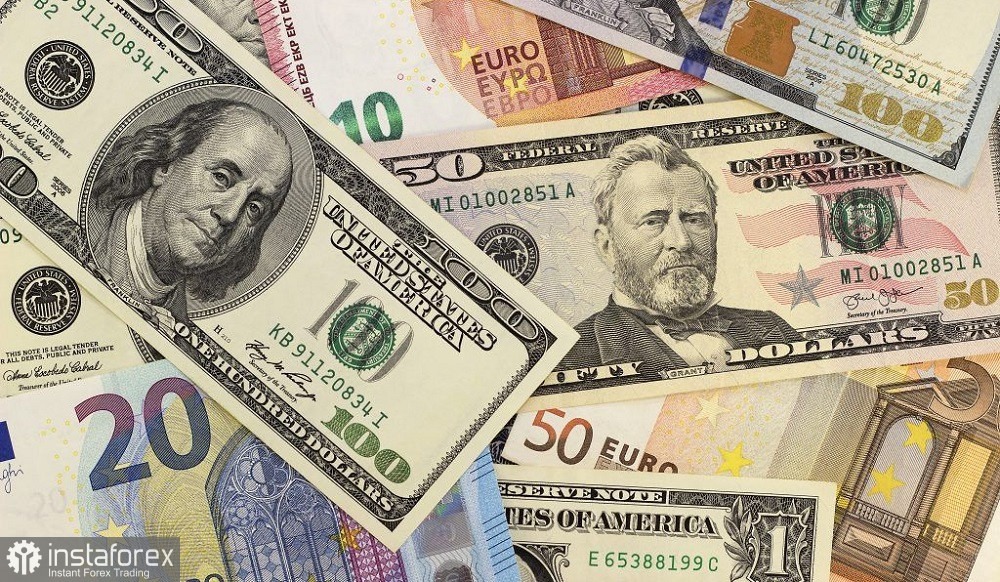The euro-dollar pair continues to drift within the price range of 1.0650-1.0770, where it has been trading for the second consecutive week. Yesterday, EUR/USD buyers attempted to break through the upper boundary of the range, with Thursday's high recorded at 1.0778. However, traders failed to sustain above the 1.0770 level: today, bears regained control, extinguishing the upward momentum. Overall, nothing is surprising about this. There are no grounds for a sustainable upward trend in EUR/USD at the moment.

Moreover, in anticipation of the ECB and Fed meetings in June, stable trending movements in either direction are inherently impossible, as central banks can easily "redraw" the fundamental background for the pair. The intrigue remains, and this applies to both the Federal Reserve and the European Central Bank. Possible surprises of hawkish or dovish nature keep both buyers and sellers of EUR/USD on their toes. Traders are reluctant to "play long" and therefore close their positions when approaching the boundaries of the 8th figure or when the rate drops to around 1.0650.
Dilemma for the ECB
Friday is a slow day for the pair. The economic calendar lacks significant events, and the speech by ECB Vice President Luis de Guindos only sparked minor interest. However, it also failed to provide additional support to the pair, despite conveying somewhat hawkish messages. Essentially, de Guindos reiterated his earlier rhetoric. Last week, he commented on the inflation growth data in the Eurozone (which reflected a slowdown in the consumer price index), stating that the published figures were "positive but still far from target levels." In this context, he added that the European Central Bank still has a certain path to follow regarding rate hikes.
Overall, leading up to the ECB meeting in June, representatives of the European regulator maintain a hawkish stance. However, judging by the indecisive dynamics of EUR/USD, traders are unsure whether the central bank will demonstrate an aggressive stance next week. At least, the recent macroeconomic releases do not contribute to strengthening the hawkish position. It should be noted that the Eurozone's overall consumer price index decreased to 6.1% in May versus the forecasted decline to 6.3%, marking the slowest growth pace since March 2022. The core inflation rate, excluding energy and food prices, decreased to 5.3% (forecasted growth was 5.6%). This component has been declining for the second consecutive month.
And it's not just inflation that has entered the "red zone": yesterday, for example, it was revealed that the Eurozone has indeed slipped into a recession. According to Eurostat's second estimate, GDP contracted by 0.1% in the first quarter on a quarterly basis. In annual terms, the Eurozone's economy grew by only 1.0% (initial estimate was 1.2%).
How these data will affect the rhetoric/decisions of the ECB remains an open question. Therefore, market participants are wary of the hawkish statements made by representatives of the European Central Bank.
Dilemma for the Fed
A similar situation has unfolded for the Federal Reserve. There is a so-called "quiet period," but before its onset, Fed representatives voiced conflicting rhetoric. According to some officials (including Fed Chair Jerome Powell), the American regulator may pause the rate hike. They argue their position based on the crisis in the banking sector and the decline in many macroeconomic indicators. For example, the latest ISM indices in the service and manufacturing sector fell into the "red zone," significantly falling short of forecasted values.
Representatives of the hawkish wing of the Fed still insist on a rate hike, pointing to the growth of the core PCE index and the slow decline of other inflationary indicators (particularly the CPI).
Which way the scales will tip on June 14 is still an open question. It is precisely for this reason that EUR/USD traders react so sharply to any significant macroeconomic reports that may influence the sentiment of members of the American regulator.
In particular, the greenback weakened across the market yesterday in response to the rise in initial jobless claims in the U.S. The figure rose to 261,000 this week (forecasted growth was 230,000), while it stood at 233,000 the previous week. The indicator has been rising for the third consecutive week, and at a fairly active pace. The dollar weakened across the market, the yield on 10-year U.S. Treasury bonds sharply declined, and the EUR/USD pair reached a local high, rising to 1.0778.
Conclusions
Judging by the price action of EUR/USD, traders are plagued by doubts—both buyers and sellers. This state of affairs is likely to persist, at least, until the announcement of the outcome of the June Federal Reserve meeting (June 14).
The failed upward attack launched by EUR/USD bulls yesterday confirms this assumption. Therefore, in the coming days, the pair will likely trade within the established price range of 1.0650-1.0770.
 English
English 
 Русский
Русский Bahasa Indonesia
Bahasa Indonesia Bahasa Malay
Bahasa Malay ไทย
ไทย Español
Español Deutsch
Deutsch Български
Български Français
Français Tiếng Việt
Tiếng Việt 中文
中文 বাংলা
বাংলা हिन्दी
हिन्दी Čeština
Čeština Українська
Українська Română
Română

